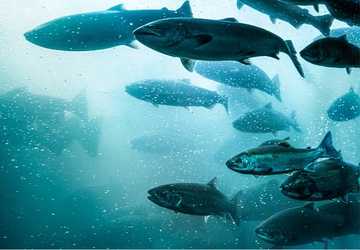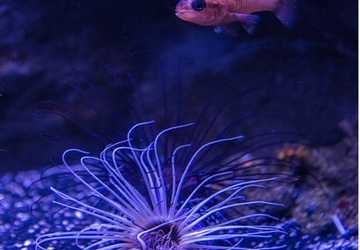Maintaining an aquarium is an intricate and gratifying endeavor, necessitating meticulous attention to the inhabitants' well-being. Identifying the signs of stress in aquarium fish ensures their health and vitality. Stress, if unaddressed, can precipitate significant health complications. This exposition delves into the myriad indicators of piscine stress and proffers efficacious remedies to mitigate it.
Common Signs of Stress in Aquarium Fish

Awareness of the signs of stress in aquarium fish is critical for timely intervention. Here are several prevalent indicators:
- Inappetence: A conspicuous decline in appetite can be a salient sign of stress.
- Erratic Locomotion: Aberrant swimming patterns, such as frantic bursts or lingering at the aqueous surface, often denote stress.
- Seclusion: Fish that commence frequent concealment may be experiencing stress.
- Chromatic Aberrations: A fish that loses its effulgent coloration is likely under duress.
- Dyspneic Respiration: Rapid gill movement or surface gasping can indicate distress.
- Retracted Fins: Fins held close to the soma rather than deployed can be a stress indicator.
- Belligerence: Amplified aggression towards conspecifics can be a manifestation of stress.
- Lassitude: Fish displaying torpid or indolent behavior may be stressed.
- Physical Anomalies: Observable signs like lacerated fins or ulcers can indicate distress.
How to Tell if Fish is Stressed
To discern whether fish is stressed, meticulously observe their behavior and bodily condition. Detailed steps include:
- Monitor Ingestive Patterns: An abrupt loss of appetite or refusal to consume victims is an early precursor.
- Analyze Locomotive Behavior: Unusual or erratic motility should prompt consternation.
- Assess Social Interactions: Escalated aggression or seclusion can be stress indicators.
- Examine Somatic Appearance: Look for chromatic changes, retracted fins, and physical damage such as ulcers or lacerated fins.
- Observe Respiratory Patterns: Accelerated respiration or surface gasping should be noted.
Fish Stress Symptoms and Remedies
Comprehending fish stress symptoms and remedies is indispensable for prompt intervention. Common symptoms and their remedies include:
- Inappetence
- Remedy: Ensure optimal aqueous quality and proffer a varied diet to stimulate ingestion.
- Erratic Locomotion
- Remedy: Scrutinize water parameters or introduce concealment spots to attenuate stress.
- Seclusion
- Remedy: Provide ample concealment places and ensure a stable aquatic environment.
- Chromatic Aberrations
- Remedy: Maintain aqueous quality and mitigate environmental stressors such as abrupt lighting alterations.
- Dyspneic Respiration
- Remedy: Augment aeration and examine the aqueous milieu for toxins like ammonia.
- Retracted Fins
- Remedy: Enhance water quality and alleviate stress sources, such as belligerent tank mates.
- Belligerence
- Remedy: Isolate aggressive piscine or provide more spatial capacity to reduce territorial conflicts.
- Lassitude
- Remedy: Scrutinize water parameters and ensure a balanced dietary regimen.
- Physical Anomalies
- Remedy: Treat injuries or infections promptly and ameliorate overall tank conditions.
Preventing Stress in Aquarium Fish
Prevention is always preferable to remediation. Here are strategies to keep your fish stress-free:
- Maintain Optimal Aqueous Quality: Regularly assay water parameters and perform changes to ensure a stable milieu.
- Proffer a Nutritious Diet: Ensure your fish receive a varied and healthful diet.
- Create a Secure Environment: Incorporate concealment spots and flora to emulate natural habitats.
- Avoid Overcrowding: Ensure your tank is appropriately stocked to avert territorial altercations.
- Minimize Sudden Alterations: Avoid abrupt changes in water temperature, lighting, and tank setup.
- Regular Surveillance: Monitor your fish's behavior and appearance to detect early signs of stress.
- Automated Aquatic Surveillance: Employ technology to continuously monitor water parameters and alert for deviations.
- Biotope Emulation: Create an environment that closely emulates the natural biotope of the fish.
- Rigorous Quarantine Protocols: To prevent pathogen transmission, new fish must be quarantined before being integrated into the main tank.
- Environmental Enrichment: To maintain piscine engagement, introduce environmental enrichments such as flora, decorations, and periodic alterations in tank setup.
- Diverse Dietary Regimen: Provide a diet that mimics the fish's natural dietary habits, encompassing live, frozen, and pelletized sustenance.
Advanced Signs of Stress in Aquarium Fish

Subtle Behavioral Indicators of Stress
While some signs of stress in fish are overt, others are more subtle and nuanced. Recognizing these behaviors is essential:
- Erratic Alimentative Behavior: Not merely a loss of appetite, but irregular alimentary patterns can signify underlying stress.
- Prolonged Stasis: Fish that remain immobile in a singular location, often near the surface or substrate, may be experiencing stress.
- Hyperplasia of Mucus: An increase in the slime coat production can be an adaptive response to stress.
- Sudden Fin Abduction: Sudden abduction of fins against objects may suggest irritants in the aqueous environment.
- Restive Pacing: Continuously pacing along the aquarium glass can indicate discomfort.
Environmental Factors Leading to Stress
Various environmental parameters can induce stress in aquarium fish. Identifying and mitigating these factors is crucial:
- Illuminative Dysregulation: Excessive or insufficient photic conditions can disrupt piscine behavior.
- Hydrodynamic Inadequacies: Either excessively strong or weak hydrodynamic conditions can create a stressful milieu.
- Spatial Insufficiency: Overcrowding can precipitate territorial conflicts and induce stress.
- Thermic Oscillations: Sudden thermal fluctuations can be highly detrimental to fish.
- Chemical Perturbations: Deleterious chemicals like chlorine or heavy metals in the water can induce stress.
How to Tell if Fish is Stressed in a Community Tank
Identifying stress in a community tank is challenging due to the diverse piscine inhabitants. Here are specific strategies:
- Isolated Scrutiny: Periodically isolate and scrutinize individual fish for thorough health assessments.
- Behavioral Comparatives: Compare the behavior of disparate species within the tank.
- Tank Interactions: Observe interspecific and intraspecific interactions, noting aberrant aggression or submissiveness.
- Episodic Evaluations: Regularly inspect the tank for physical damage or signs of disease outbreaks.
Fish Stress Symptoms and Remedies in Different Fish Species
Different species manifest unique stress symptoms. Understanding these idiosyncrasies is imperative for addressing stress:
- Cichlids: Characterized by heightened territorial aggression when stressed.
- Remedy: Augment hiding places and consider reconfiguring tank layouts to disrupt established territories.
- Tetras: Schooling fish that may exhibit isolation behaviors under duress.
- Remedy: Maintain adequate group sizes to facilitate natural schooling behavior.
- Goldfish: Prone to buoyancy disorders when stressed.
- Remedy: Maintain impeccable water conditions and eschew overfeeding.
- Betta Fish: May exhibit fin necrosis and chromatic dimming under stress.
- Remedy: Provide a serene environment with minimal disturbances and compatible tank mates.
Conclusion
Identifying the signs of stress in aquarium fish is essential for maintaining a healthful tank. Understanding how to tell if a fish is stressed and recognizing fish stress symptoms and remedies enables the creation of a stable and tranquil environment for your aquatic denizens. Regular observation and proactive care are key to preventing stress and ensuring fish flourish.
